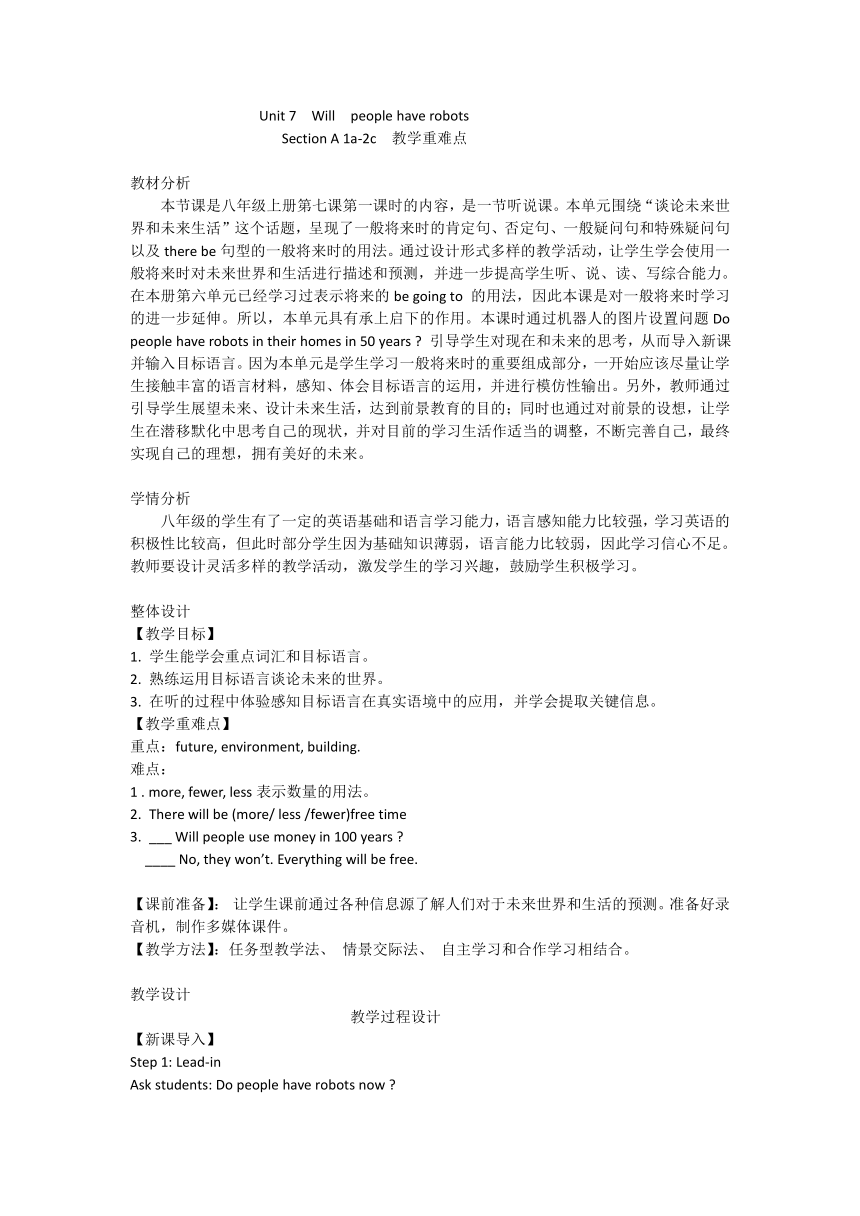Unit 7 Will people have robots Section A 1a-2c 教案
文档属性
| 名称 | Unit 7 Will people have robots Section A 1a-2c 教案 |  | |
| 格式 | zip | ||
| 文件大小 | 15.6KB | ||
| 资源类型 | 教案 | ||
| 版本资源 | 人教新目标(Go for it)版 | ||
| 科目 | 英语 | ||
| 更新时间 | 2023-01-19 18:03:53 | ||
图片预览

文档简介
Unit 7 Will people have robots
Section A 1a-2c 教学重难点
教材分析
本节课是八年级上册第七课第一课时的内容,是一节听说课。本单元围绕“谈论未来世界和未来生活”这个话题,呈现了一般将来时的肯定句、否定句、一般疑问句和特殊疑问句以及there be句型的一般将来时的用法。通过设计形式多样的教学活动,让学生学会使用一般将来时对未来世界和生活进行描述和预测,并进一步提高学生听、说、读、写综合能力。在本册第六单元已经学习过表示将来的be going to 的用法,因此本课是对一般将来时学习的进一步延伸。所以,本单元具有承上启下的作用。本课时通过机器人的图片设置问题Do people have robots in their homes in 50 years 引导学生对现在和未来的思考,从而导入新课并输入目标语言。因为本单元是学生学习一般将来时的重要组成部分,一开始应该尽量让学生接触丰富的语言材料,感知、体会目标语言的运用,并进行模仿性输出。另外,教师通过引导学生展望未来、设计未来生活,达到前景教育的目的;同时也通过对前景的设想,让学生在潜移默化中思考自己的现状,并对目前的学习生活作适当的调整,不断完善自己,最终实现自己的理想,拥有美好的未来。
学情分析
八年级的学生有了一定的英语基础和语言学习能力,语言感知能力比较强,学习英语的积极性比较高,但此时部分学生因为基础知识薄弱,语言能力比较弱,因此学习信心不足。教师要设计灵活多样的教学活动,激发学生的学习兴趣,鼓励学生积极学习。
整体设计
【教学目标】
学生能学会重点词汇和目标语言。
熟练运用目标语言谈论未来的世界。
在听的过程中体验感知目标语言在真实语境中的应用,并学会提取关键信息。
【教学重难点】
重点:future, environment, building.
难点:
1 . more, fewer, less表示数量的用法。
There will be (more/ less /fewer)free time
___ Will people use money in 100 years
____ No, they won’t. Everything will be free.
【课前准备】: 让学生课前通过各种信息源了解人们对于未来世界和生活的预测。准备好录音机,制作多媒体课件。
【教学方法】:任务型教学法、 情景交际法、 自主学习和合作学习相结合。
教学设计
教学过程设计
【新课导入】
Step 1: Lead-in
Ask students: Do people have robots now
Some students would probably say that the robots are working in factories
【新知呈现】
Step 2: Presentation
Ask students two questions:
Will people have robots in their homes in 50 years
Will people have robots in their homes in 100 years
【新知呈现】 听力活动
Step 3: Listening to 1a
Before listening to ask students:
To read the predictions in 1a;
To check A for agree and D for disagree;
To discuss their ideas with their partners following the example in 1c;
T : What are other people’s predictions
观察与思考:引导学生在听前浏览、预测、和判断信息,形成信息期待。
While listening to work on 1b
Ask students to listening for the first time and circle the predictions their hear.
Listen and check the answers
Listen and repeat to improve their pronunciation and intonation.
Step 4: Work on 2a and 2b.
T : What about people ,free time ,pollution, cars, trees in the future
Before listening, ask students to circle the words according to their own predictions.
Listen and circle the words you hear.
Check the answers.
Listen again.Check (√)the predictions they hear.
Listen and repeat to improve their pronunciation and intonation.
Step 5: Work on 2c
Make conversations about the predictions in 2a and 2b
The teacher gives evaluation.
【重难点突破总结】
There be 句型的一般将来时 there will be .
More, less, fewer的用法。
辨析:more, less, fewer
More 是much, many的比较级,意味“更多的,较多的”,修饰不可数名词或可数名词。Less 是little的比较级,以为“较少的,更少的”只能修饰不可数名词。
fewer是few的比较级,意味“较少的”,修饰可数名词。
课堂小结
观察与思考:
让学生自主学习,再以四人一组进行讨论:
本节课学习了哪些内容 ?
我们在使用more, less, fewer应注意些什么 ?
教师总结:
本节课我们初步了解了一般将来时的表意功能和语言形式(包括there be 结构在一般将来时中的用法)和正确使用more, less, fewer 表示数量,学会了正确使用一般将来时对我们将来进行预测。
课后作业:
未来100年后的生活是怎样的,请你写出五个以上的预言。
I think ---in100 years。
板书设计
Unit 7 will people have robots?
Section A1a-2c
1. Words: future, environment, building.
2.Sentences:
1) . ___ Will people use money in 100 years
___ No, they won’t. Everything will be free.
2). There will be ( more,/ less, / fewer ) free time.
教学反思
本课重难点设计体现了任务型教学的设计理念。整个任务链的设计均围绕学生生活实际,逐层递进,逐步完成各个环节,最大限度地调动每一位学生学习的积极性;对于听力部分,在听之前都做了相关的渗透与铺垫,听中有方法与技巧的指导,听后有新的语言的生成,使学生在每一个信息任务中体验英语学习的乐趣。
本节课中也存在着有待改进的地方:在突破重难点的过程中,学生合作学习的实效性仍有待加强。
Section A 1a-2c 教学重难点
教材分析
本节课是八年级上册第七课第一课时的内容,是一节听说课。本单元围绕“谈论未来世界和未来生活”这个话题,呈现了一般将来时的肯定句、否定句、一般疑问句和特殊疑问句以及there be句型的一般将来时的用法。通过设计形式多样的教学活动,让学生学会使用一般将来时对未来世界和生活进行描述和预测,并进一步提高学生听、说、读、写综合能力。在本册第六单元已经学习过表示将来的be going to 的用法,因此本课是对一般将来时学习的进一步延伸。所以,本单元具有承上启下的作用。本课时通过机器人的图片设置问题Do people have robots in their homes in 50 years 引导学生对现在和未来的思考,从而导入新课并输入目标语言。因为本单元是学生学习一般将来时的重要组成部分,一开始应该尽量让学生接触丰富的语言材料,感知、体会目标语言的运用,并进行模仿性输出。另外,教师通过引导学生展望未来、设计未来生活,达到前景教育的目的;同时也通过对前景的设想,让学生在潜移默化中思考自己的现状,并对目前的学习生活作适当的调整,不断完善自己,最终实现自己的理想,拥有美好的未来。
学情分析
八年级的学生有了一定的英语基础和语言学习能力,语言感知能力比较强,学习英语的积极性比较高,但此时部分学生因为基础知识薄弱,语言能力比较弱,因此学习信心不足。教师要设计灵活多样的教学活动,激发学生的学习兴趣,鼓励学生积极学习。
整体设计
【教学目标】
学生能学会重点词汇和目标语言。
熟练运用目标语言谈论未来的世界。
在听的过程中体验感知目标语言在真实语境中的应用,并学会提取关键信息。
【教学重难点】
重点:future, environment, building.
难点:
1 . more, fewer, less表示数量的用法。
There will be (more/ less /fewer)free time
___ Will people use money in 100 years
____ No, they won’t. Everything will be free.
【课前准备】: 让学生课前通过各种信息源了解人们对于未来世界和生活的预测。准备好录音机,制作多媒体课件。
【教学方法】:任务型教学法、 情景交际法、 自主学习和合作学习相结合。
教学设计
教学过程设计
【新课导入】
Step 1: Lead-in
Ask students: Do people have robots now
Some students would probably say that the robots are working in factories
【新知呈现】
Step 2: Presentation
Ask students two questions:
Will people have robots in their homes in 50 years
Will people have robots in their homes in 100 years
【新知呈现】 听力活动
Step 3: Listening to 1a
Before listening to ask students:
To read the predictions in 1a;
To check A for agree and D for disagree;
To discuss their ideas with their partners following the example in 1c;
T : What are other people’s predictions
观察与思考:引导学生在听前浏览、预测、和判断信息,形成信息期待。
While listening to work on 1b
Ask students to listening for the first time and circle the predictions their hear.
Listen and check the answers
Listen and repeat to improve their pronunciation and intonation.
Step 4: Work on 2a and 2b.
T : What about people ,free time ,pollution, cars, trees in the future
Before listening, ask students to circle the words according to their own predictions.
Listen and circle the words you hear.
Check the answers.
Listen again.Check (√)the predictions they hear.
Listen and repeat to improve their pronunciation and intonation.
Step 5: Work on 2c
Make conversations about the predictions in 2a and 2b
The teacher gives evaluation.
【重难点突破总结】
There be 句型的一般将来时 there will be .
More, less, fewer的用法。
辨析:more, less, fewer
More 是much, many的比较级,意味“更多的,较多的”,修饰不可数名词或可数名词。Less 是little的比较级,以为“较少的,更少的”只能修饰不可数名词。
fewer是few的比较级,意味“较少的”,修饰可数名词。
课堂小结
观察与思考:
让学生自主学习,再以四人一组进行讨论:
本节课学习了哪些内容 ?
我们在使用more, less, fewer应注意些什么 ?
教师总结:
本节课我们初步了解了一般将来时的表意功能和语言形式(包括there be 结构在一般将来时中的用法)和正确使用more, less, fewer 表示数量,学会了正确使用一般将来时对我们将来进行预测。
课后作业:
未来100年后的生活是怎样的,请你写出五个以上的预言。
I think ---in100 years。
板书设计
Unit 7 will people have robots?
Section A1a-2c
1. Words: future, environment, building.
2.Sentences:
1) . ___ Will people use money in 100 years
___ No, they won’t. Everything will be free.
2). There will be ( more,/ less, / fewer ) free time.
教学反思
本课重难点设计体现了任务型教学的设计理念。整个任务链的设计均围绕学生生活实际,逐层递进,逐步完成各个环节,最大限度地调动每一位学生学习的积极性;对于听力部分,在听之前都做了相关的渗透与铺垫,听中有方法与技巧的指导,听后有新的语言的生成,使学生在每一个信息任务中体验英语学习的乐趣。
本节课中也存在着有待改进的地方:在突破重难点的过程中,学生合作学习的实效性仍有待加强。
同课章节目录
- Unit 1 Where did you go on vacation?
- Section A
- Section B
- Unit 2 How often do you exercise?
- Section A
- Section B
- Unit 3 I'm more outgoing than my sister.
- Section A
- Section B
- Unit 4 What's the best movie theater?
- Section A
- Section B
- Unit 5 Do you want to watch a game show?
- Section A
- Section B
- Unit 6 I'm going to study computer science.
- Section A
- Section B
- Unit 7 Will people have robots?
- Section A
- Section B
- Unit 8 How do you make a banana milk shake?
- Section A
- Section B
- Unit 9 Can you come to my party?
- Section A
- Section B
- Unit 10 If you go to the party, you'll have a grea
- Section A
- Section B
